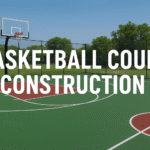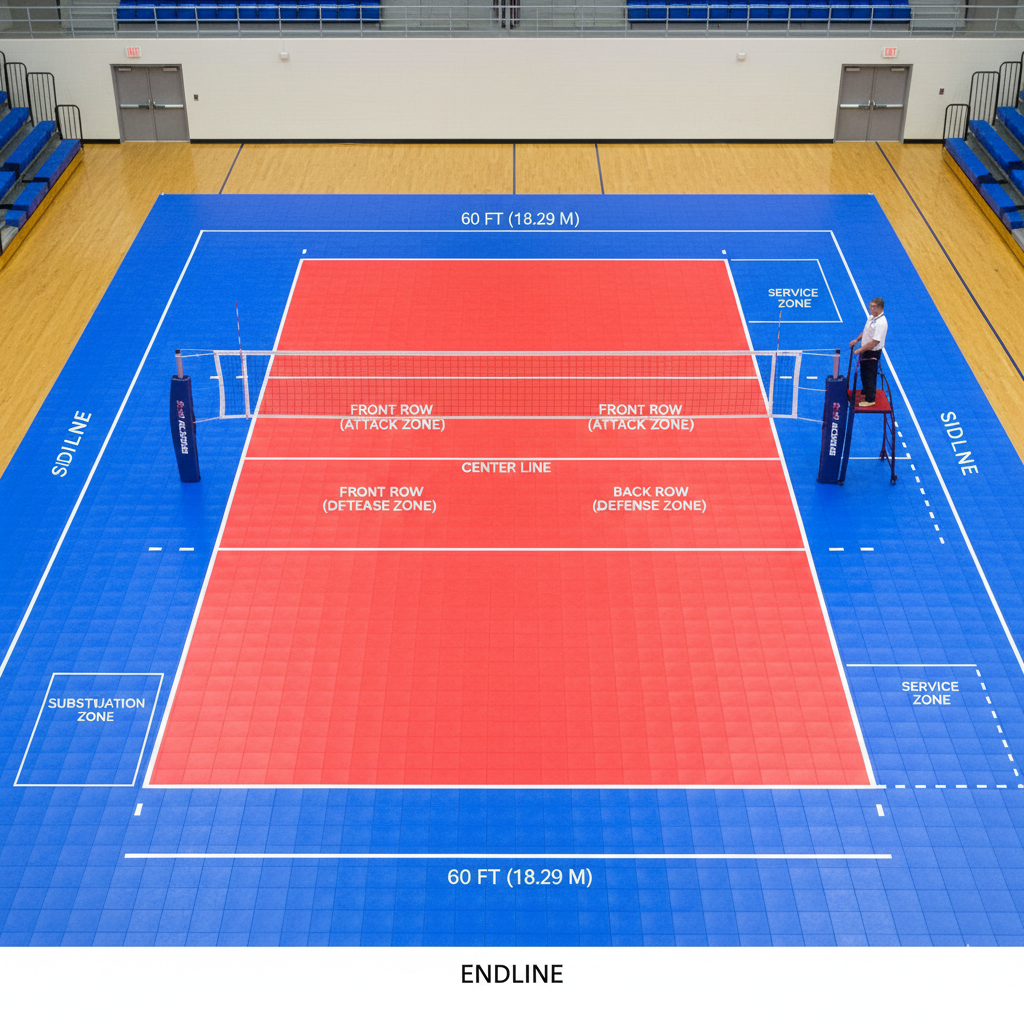Introduction
Volleyball is one of the most popular team sports worldwide, played both indoors and outdoors at recreational, school, and professional levels. To ensure consistency and fairness, the Fédération Internationale de Volleyball (FIVB) has set official rules for the dimensions and layout of a volleyball court.
Whether you are a coach, player, or facility planner, understanding the exact volleyball court size in feet and its layout markings is essential for proper training and competition.
This guide explains the official court size, net height, attack lines, free zones, and layout details in feet, with easy-to-understand calculations and diagrams in mind.
Official Volleyball Court Dimensions
According to FIVB standards, a volleyball court is a rectangle that measures:
-
Length: 59 feet (18 meters)
-
Width: 29.5 feet (9 meters)
Total Court Area
59×29.5=1,740.5 sq ft59 \times 29.5 = 1,740.5 \, \text{sq ft}59×29.5=1,740.5sq ft
✅ So, the official playing area of a volleyball court is about 1,741 square feet.
Free Zone and Playing Space
The official court is not the only space required. Extra free zones around the court allow players to chase and play the ball without obstruction.
-
Free Zone (minimum): 9.8 feet (3 meters) on all sides
-
Overhead Clearance: 22.9 feet (7 meters) minimum
This means the total required space for a full volleyball setup is much larger than the court itself.
Total Playing Space (Including Free Zone):
-
Length = 59 + (9.8 × 2) = 78.6 feet
-
Width = 29.5 + (9.8 × 2) = 49.1 feet
78.6×49.1=3,860 sq ft (approx.)78.6 \times 49.1 = 3,860 \, \text{sq ft (approx.)}78.6×49.1=3,860sq ft (approx.)
✅ So, a volleyball facility requires around 3,860 sq ft for one court with clearance.
Volleyball Court Layout and Markings
The volleyball court has several important lines and markings that define gameplay zones.
1. Boundary Lines
-
All lines are 2 inches (5 cm) wide.
-
The boundary includes end lines (along the width) and sidelines (along the length).
2. Center Line
-
Divides the court into two equal halves of 29.5 ft × 29.5 ft.
-
Each team plays on one half.
3. Attack Line (Three-Meter Line)
-
Drawn 9 ft 10 in (3 meters) from the center line on each side.
-
Separates frontcourt and backcourt areas.
-
Back-row players cannot attack in front of this line.
4. Service Zone
-
Located behind the end line.
-
Extends the full width of the court (29.5 ft) and backward at least 9.8 ft (3 meters).
5. Substitution Zone & Coach’s Area
-
Marked outside sidelines.
-
Coaches must remain in their designated zones during play.
Net Height and Posts
The net is one of the most important elements in volleyball, and its height differs by category.
-
Men’s Net Height: 7 ft 11 5/8 in (2.43 meters)
-
Women’s Net Height: 7 ft 4 1/8 in (2.24 meters)
-
Junior/Youth: Between 6 ft 6 in (2.0 m) and 7 ft (2.13 m), depending on age.
Net Dimensions
-
Length: 32.8 feet (10 meters)
-
Width (height): 3 feet (1 meter)
-
Posts: Placed 3 feet (1 meter) outside each sideline.
Court Division for Teams
Each side of the court is further divided into zones:
-
Frontcourt Area (attack zone): From center line to attack line → 9 ft 10 in depth.
-
Backcourt Area (defensive zone): From attack line to end line → 19 ft 6 in depth.
-
Service Zone: Behind each end line.
This layout ensures balanced offensive and defensive play.
Indoor vs. Beach Volleyball Court Sizes
While indoor volleyball is the standard form, beach volleyball has slightly different dimensions.
Indoor Court
-
59 ft × 29.5 ft = 1,741 sq ft
-
Played with 6 players per team
Beach Court
-
52.5 ft × 26.25 ft = 1,379 sq ft
-
Played with 2 players per team
Beach courts are smaller to suit the reduced number of players and the slower movement in sand.
Comparison of Court Sizes
| Type | Length (ft) | Width (ft) | Area (sq ft) |
|---|---|---|---|
| Indoor Volleyball | 59 | 29.5 | 1,741 |
| Beach Volleyball | 52.5 | 26.25 | 1,379 |
| Total Space w/ Free Zone | 78.6 | 49.1 | 3,860 |
Importance of Standard Dimensions
Using official volleyball court dimensions ensures:
-
Fair Play: All players compete on equal grounds.
-
Player Safety: Free zones prevent injuries during dives and chases.
-
Training Accuracy: Consistency across courts allows effective practice.
-
Tournament Readiness: Facilities that meet FIVB standards can host professional competitions.
-
Efficient Space Planning: Helps architects and sports complexes design halls properly.
Conclusion
The standard volleyball court size is 59 feet × 29.5 feet (1,741 sq ft), with each half measuring 29.5 ft × 29.5 ft. When buffer zones are included, a full volleyball setup requires nearly 3,860 sq ft of space.
Court markings such as the center line, attack line, service zone, and boundary lines play a vital role in gameplay, while the net height ensures fairness across different categories of players.
For recreational setups, slightly adjusted courts may work, but for official tournaments, strict compliance with FIVB standards is necessary.
A well-planned volleyball court not only supports smooth gameplay but also helps athletes perform at their best while ensuring safety and fairness.




